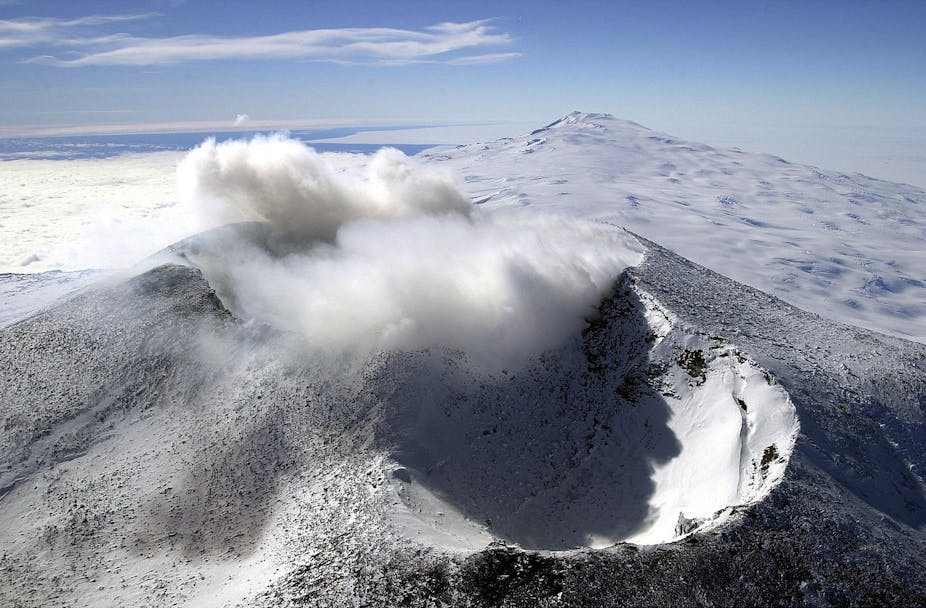The Thwaites glacier is one of the most rapidly changing in Antarctica. It’s been the focus of considerable attention in recent weeks, after scientists suggested that this sector of the huge West Antarctic Ice Sheet was already on route towards collapse due to warming ocean temperatures. A major collapse of this part of the ice sheet could have dire consequences worldwide, with a global sea level rise of potentially up to 1m. Some models suggest this could take place comparatively rapidly, within a few centuries.
But hidden beneath the kilometres of ice in this rapidly changing part of the continent is a largely unexplored geological feature: the West Antarctic Rift System, a strip of volcanic activity thought to extend for more than 3,000km across the Antarctic continent, provides further heat to melt the ice sheet from below.
The rift is where the Earth’s crust has in the past been stretched, pushing magma near to the surface and causing widespread volcanic activity. It’s important to establish the amount of volcanic heat from the rift in order to more accurately predict the response of the Thwaites glacier and entire West Antarctic Ice Sheet to the effects of a warming climate and ocean.
Direct measurements of the geothermal heat flux from the rift are however difficult and expensive to obtain – the overlying ice sheet is in places 4km thick. Estimates of geothermal heat flux available so far are derived mainly from satellite magnetic data or seismology that struggle to resolve the regional details required to understand what effects the heat would have on the ice sheet.
In a paper published in Proceedings of the National Academy of Sciences of the US, researchers from the Institute for Geophysics at The University of Texas, Austin, report a new method of estimating the geothermal heat flux beneath Thwaites glacier. Using radar data to map how water flows under the ice sheet and estimate ice melting rates, they have identified significant sources of high geothermal heat.

According to lead author Dustin Shroeder (who now works at NASA), these appear to be distributed over a much wider area than previously thought. The minimum average geothermal heat flow beneath Thwaites glacier is about 100 milliwatts per square metre, with some hotspots reaching 200 milliwatts per square metre. This is considerably higher than the average heat flow of the Earth’s continents, at less than 65 milliwatts per square metre.
Detecting such high geothermal heat flux within this part of West Antarctic Rift means that there is likely to be much more water beneath Thwaites glacier. The presence of water can lubricate and speed up the flow of glaciers, even in the deep interior of the ice sheet kilometres beneath the surface. Several models used to simulate the present ice sheet assume much lower geothermal heat for the region, or less variability in heat flow than what the study team has proposed. As Schoreder said, the combination of heat and water interacting with the glacier’s base could “threaten the stability of Thwaites glacier in ways that we never before imagined.”
We need to carry out further geophysical research, with other methods, to validate the predictions of such high geothermal heat that the team has derived from radar data analysis alone. Magnetic and gravity methods have been used, for example, to study rifts and geothermal heat flux patterns in many regions worldwide, and could be applied here to obtain an independent perspective.
We also need more data and further computer modelling to try to understand more fully what impact this high geothermal heat has on the flow of water underneath glaciers, how this affects ice sheet dynamics, and ultimately how this will further our understanding of how Antarctica is responding to a warming world.
This remarkable study is focused on the variability of geothermal heat beneath the Thwaites glacier that may have a bearing on ice dynamics in this vulnerable part of Antarctica. The level of heat in the rift system inferred from radar probe data doesn’t imply that ocean warming driven by global warming is not a significant contributor to the ice loss seen in this part of West Antarctica.
This study does not address ice sheet stability directly at all – it neither supports nor refutes the recent studies’ conclusions that the Thwaites glacier is already on route to collapse. But better understanding of how geothermal heat affects the flow of water underneath glaciers will allow us to develop improved models to better predict ice sheet behaviour, and ultimately how Antarctica is responding to a warming world.

